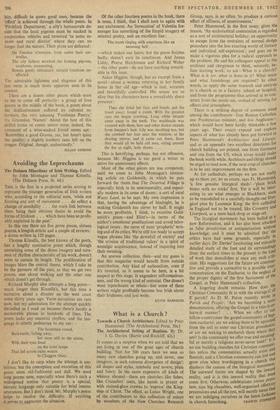What is a Church ?
Towards a Church Architecture. Edited by Peter Hammond. (The Architectural Press, 30s.) The Architectural Setting of Baptism. By Dr.
J. G. Davies. (Barrie and Rockliff, 42s.) IT comes as a surprise when we are told that we are living in one of the great ages of church building. 'Not for 500 years have we seen so many new churches going up, and never, one imagines, in such extreme divergence of design'; all shapes and styles, symbolic and severe, plain and fancy. In the more expensive all kinds of whimsy abound---there are churches like fishes, like Crusaders' tents, like hands in prayer or with stained-glass crowns to 'express' the King- ship of Christ. The effect, as Lance Wright, one of the contributors to this collection of essays by members of the New Churches Research Group, says, is so often 'to produce a curious effect of silliness, of unseriousness.'
Peter Hammond, in the first essay, gives the reason. 'An ecclesiastical commission is regarded as a sort of architectural holiday; an opportunity to escape from the restraints of normal design procedure into the less exacting world of fantasy and individual self-expression'; and goes on to make a vigorous plea for a radical approach to the problem. He and his colleagues appeal to the architect and clergyman to think, seriously, be- fore starting work; to ask--What is a church? What is it for, what is done. in it? What space and what furnishings are required? In other words, to apply the same research and analysis to a church as to a factory, school or hospital, and from the programme thus arrived at to con- struct from the inside out, instead of striving for effects and atmosphere.
There is a striking degree of common mind among the contributors—four Roman Catholics, one Presbyterian minister, and five Anglicans— which would have been hardly thinkable a few years ago. Their essays expand and explore aspects of what has already been put forward in Peter Hammond's Architecture and Liturgy; and as an appendix two excellent directions for church building are printed, one from GermanY and one from the US, which alone would make the book worth while. Architects and clergy should be urged to read now, if the next crop of churches is to be any improvement on the first. As for cathedrals, perhaps we are not reallY up to them yet; let us create, says Fr. Hammond, 'a few genuine liturgical sheds'—‘plain brick boxes with no tricks' first. Yet it will be inter- esting to see what emerges at Blackburn, soon to be remodelled to a carefully-thought-out litur- gical plan by Laurence King; the first cathedral in England not to be treated, like Coventry and Liverpool, as a mere back-drop or stage-set. The liturgical movement has been hailed as a, new Reformation, and it has also been attack' as false primitivism or antiquarianism without knowledge; and it must be admitted that the critics have had some grounds, especially in earlier days. Dr. Davies' fascinating and minutelY detailed study of the font and its surroundings from the earliest times to the present is the kind of work that demolishes at once any such criti- cism. His suggestions for the future are construe- tive and provide a corrective to a possible over; concentration on the Eucharist, to the neglect 0' the proper dignity of the first Sacrament of the Gospel, in Peter Hammond's collection. A lingering doubt remains. How does the, Christian Community fit in with the average C E parish? As D. M. Paton recently wrote n' Parish and People: 'Are we becoming a mere denomination, offering the Gospel in a take-it-or- Ieave-it manner? . . . When we offer to our fellow-countrymen the gospel-community of 110; tism-eucharist, are we asking them to be uprooteu from the soil to enter our Christian greenhouse, or are we seeking to enchurch them where theY are? Is the community we offer true and rneaniq: ful or merely a religious never-never land? It no use building churches for Christian cornmollid ties unless the communities actually exist 3,rid flourish; and a Christian community can live grow eVen when worshipping in a church disobeys the canons of the liturgical movenlerld The outward forms are shaped by the insvar, reality, and it is this inward reality that 11l11'.! come first. Otherwise, celebrations versus P°Pru !urn, nice big chasubles, well-organised offertoZt processions and all the rest, will merely mean th we are indulging ourselves in the latest fashiL011:






























 Previous page
Previous page